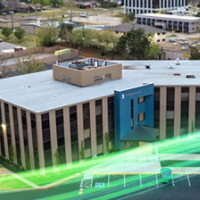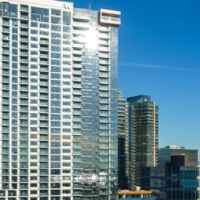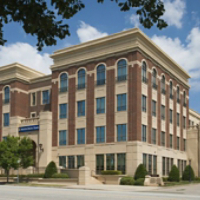Customer Story
Sustainable Transformation: Trane’s Thermal Energy Storage System at 11 Madison Avenue, NYC
Discover how Trane’s innovative Thermal Energy Storage (TES) system helped SL Green Realty reduce greenhouse gas emissions and achieve significant cost savings while enhancing the cooling efficiency of the iconic 11 Madison Avenue building in Manhattan.
Quick Facts
- Industry
- Commercial Real Estate
- Products
- Chillers • Controls • Energy Storage • CALMAC ™ Ice Bank™ Energy Storage – Model A • Centrifugal Chillers
- Topics
- Efficiency • Cost-Saving • Thermal • Decarbonization • Smart Buildings • Sustainability
- Services
- Energy Analysis & Monitoring • Intelligent Services
Challenge
11 Madison Avenue, an Art Deco marvel located in Manhattan’s Midtown South neighborhood, has for more than 70 years stood for the finest in New York architecture and innovation, while reflecting the city’s dynamic evolution and reinvention.
SL Green Realty, which owns 11 Madison Avenue, is a pioneer in building sustainability. Among the company’s sustainability initiatives was installing an energy-efficient system that would cool the building, while continuing to decrease greenhouse gas (GHG) emissions.
In fact, the one million buildings that carve out New York City’s famed skyline contribute nearly 70% of the city’s carbon emissions1 and, according to the Urban Green Council, claim 95% of the city’s electricity use. Cooling systems are among the top offenders. The U.S. Small Business Administration reports that heating, ventilation and air conditioning (HVAC) equipment accounts for 40% of energy use in commercial buildings.
SL Green’s pioneering sustainability commitment, including the 11 Madison Avenue project, was in full force when the landmark Climate Mobilization Act passed in April 2019. The legislation raised sustainability’s already high-priority position in New York City by requiring SL Green and other owners of city buildings larger than 25,000 square feet to reduce their 2005 GHG emissions by 40% by 2030 and 80% by 2050. The legislation is the most aggressive climate bill adopted by any city in the world. SL Green’s portfolio-wide sustainability goal is a 30% reduction by 2025.
The Solution
SL Green’s long-term sustainability commitment, combined with New York City’s groundbreaking GHG emissions legislation, created a prime opportunity for installing a thermal energy storage (TES) system at 11 Madison Avenue. Sony, WME and Yelp are among the tenants benefiting from the system.
Taking the Long View on Building Sustainability
The project accomplishes more than furthering SL Green’s social obligation to its employees, tenants, partners and resilient New York State and New York City communities. It also showcases how capital investments in building sustainability can simultaneously deliver environmental benefits and financial returns.
Going Further Together
For SL Green, Trane was the natural choice for designing, building, installing and servicing the TES system. Over the past 15 years, Trane has built an industry-leadership position around completing high-profile storage-technology projects in fully occupied buildings in densely populated urban locations – with minimal or no tenant interruption. Trane also distinguished itself with system expertise acquired as the developer of the largest number of TES projects in New York City.
Supercharging Results with Partnership and Planning
11 Madison Avenue’s new TES system was in every way an SL Green and Trane partnership steeped in trust. The team’s planning included an in-depth analysis of existing building operations and energy consumption as well as available square footage. SL Green’s sustainability goals were also critical factors in developing performance models and system recommendations.
Con Edison – an electric, gas and steam-services provider to customers in New York City and New York State’s Westchester County – was also a valued team member, providing guidance on the incentives they offer building owners to reduce peak electricity demand.
Conquering Challenges Head-On
The project was an arduous and complex undertaking performed within a tight four-month timeline, from site preparation to commissioning. It was made all the more challenging by the need to have project phases completed in a fully functioning and occupied vintage building with approximately 2.3 million square feet – and in a basement worksite four levels below ground.
The stakes were high for an expertly coordinated and executed project. Yet, through well-planned engagement and alignment, construction and operations team members, from design engineers to project managers, exceeded expectations and overcame every challenge, without any interruption in building operations.
Whether navigating within confined spaces, lowering and raising heavy materials to and from the underground worksite, assembling equipment on site, or managing more than 20 contractors, the team consistently delivered on its commitment – and completed the project approximately three weeks ahead of schedule.
Tapping into Smart Technology and Customization Benefits
The Trane Thermal BatteryTM Cooling System, with its operations savings and positive sustainability impact, was selected as 11 Madison Avenue’s new TES system.
The system effectively and efficiently cools expansive spaces, and even the most creatively designed and unconventional floorplans, while advancing SL Green and New York City sustainability goals. The system’s core capabilities include capturing and storing energy produced overnight in its ice tanks for use the following day.
The cooling system, which is equipped with CALMAC® tanks, is charged during off-peak evening hours when inexpensive energy is available. Throughout the evening hours, sub-freezing glycol, produced by a custom-designed ice-making chiller, flows through tubing in the ice bank tanks, freezing the tanks overnight. Ice produced overnight can exceed 500,000 pounds during prime cooling periods. At peak daytime hours, when energy costs and demand are higher, fans positioned outside the tanks circulate and discharge the cool air from the ice, cooling the building during the day.
The system offers a precise combination of complementary features – the most energy-efficient chillers as well as high-capacity storage tanks – that squarely meets 11 Madison Avenue’s cooling and tenant needs:
- Two Energy-Efficient Centrifugal Chillers: The first is an 800-ton high-efficiency electric centrifugal chiller – .503 kilowatt/ton @ 42°F leaving water temperature. The other is an 800 dual-duty electric centrifugal chiller – 800 tons @ 40°F, 766 tons in ice-making mode (designed for 21°F leaving evaporation temperature).
- 64 Model 1105 CALMAC® Thermal Storage Tanks: The thermal storage tanks deliver 1.37 megawatts of thermal-energy storage. They also provide 640 tons of cooling over a 10-hour day (6,400 ton-hours) or 900 tons over an accelerated six-hour discharge window.
Driving Results Through Performance and Training Excellence
11 Madison Avenue reflects SL Green and Trane’s trifecta of experience, expertise and collaboration – and the crucial role post-installation attentiveness and responsiveness play in the project’s ongoing success.
Performance Data and Reporting: The building’s new TES system includes an automatic temperature-control feature that sharply distinguishes it from other systems. The feature allows Trane’s Intelligent Services to continuously monitor, evaluate and track system equipment, operator performance and the building’s overall energy consumption – and generate promised efficiencies, savings and satisfaction levels.
Trane continuously analyzes performance data in real time. Data is then transformed into visuals to best identify equipment strengths and anomalies. It also serves as a system of checks and balances to further ensure peak performance. Periodic feedback is delivered to SL Green.
Evolved Learning Opportunities: Trane Energy Service team members offer continuous training to SL Green operating engineers customized to the unique functionalities, capabilities and requirements of 11 Madison Avenue’s new system. They also generate enthusiasm for the system and its state-of-the-art technologies, along with the full benefits delivered to tenants, the environment and building infrastructure.
Training covers a range of system dynamics, from design and operation to maintenance and ongoing improvement. It also reaches beyond traditional approaches to include scenario training that prepares operating engineers to swiftly respond to any circumstance, including emergency situations, around the clock. The results are empowered operating engineers and maximized performance over the long term, while meeting financial expectations.
11 Madison Avenue was the first partnership of its kind, in terms of scope, depth and duration, for SL Green and Trane. After the project’s success, additional SL Green opportunities followed. For example, Trane partnered with SL Green on an HVAC system for the core of One Vanderbilt Avenue, and a TES system at the Daily News Building at 220 East 42nd Street.
The Results
11 Madison Avenue is a stark example of the results that can be achieved – and difference that can be made – through shared commitment, state-of-the-art equipment and technology, and cross-function collaboration.
Environmental
- 1.4 million-pound decrease in annual carbon dioxide emissions – equivalent to removing 130 cars from the road or planting 188 acres of trees
- 1,035-kilowatt reduction in electricity demand during peak summer periods
- 25% reduction in central plant kilowatt-hour consumption
Financial
- 10% reduction in tenant energy costs
- More than $730,000 in annual building energy- and operating-cost savings, while reducing the strain on the electric grid
- 5.4-year project ROI
- 2.5-year thermal storage equipment ROI
11 Madison Avenue is putting SL Green firmly on track to meeting its sustainability goal of reducing GHG emissions by 30% by 2025, and the New York City energy mandate to reduce them by 40% by 2030 and 80% by 2050. The project is also among the accomplishments that continue SL Green’s legacy of portfolio-wide sustainability, which can serve as industry best practices for not only New York but also other states for many years to come.
1 Capps, Kriston, Can New York Make Buildings Super-Efficient, Fast?, Bloomberg, May 2, 2019.



